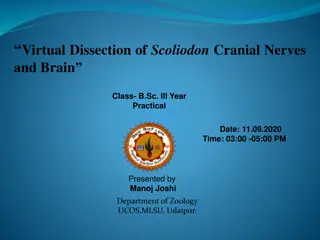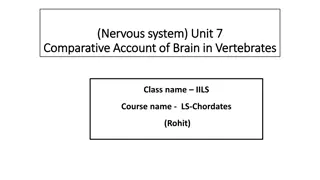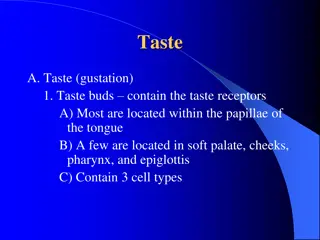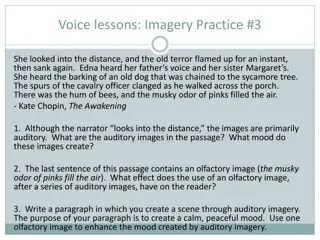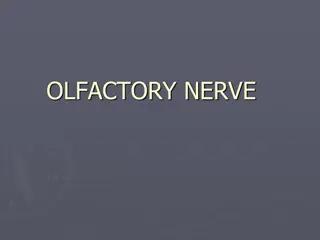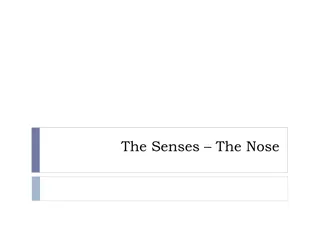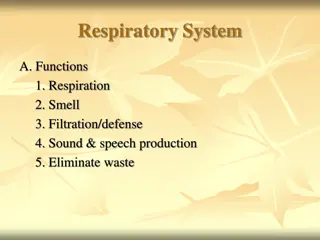Virtual Dissection of Scoliodon Cranial Nerves and Brain: A Detailed Practical Guide
Explore the virtual dissection of Scoliodon's cranial nerves and brain in this informative practical session for B.Sc. III Year students. Learn about the anatomy and innervations of various nerves like Olfactory, Optic, Trigeminal, Facial, and more. Discover the phylum, group, and class of Scoliodon
0 views • 9 slides
Comparative Analysis of Vertebrate Brains: From Cartilaginous Fish to Amphibians
The brain in vertebrates varies in size and complexity, with distinct structures like the prosencephalon and mesencephalon. From cartilaginous fishes with large olfactory lobes to bony fishes with specialized brains, the evolution of brain structures can be observed. Amphibians, like frogs, show uni
1 views • 12 slides
Understanding the Olfactory and Gustatory Systems
The olfactory sensory system is unique with direct relay to the cerebral cortex, ipsilateral representation, and the ability for regeneration. It is crucial for our sense of smell and emotional responses to odors. The gustatory area, responsible for taste perception, is closely related to the insula
0 views • 9 slides
Types of Imagery in Literature
Imagery is a powerful technique used by writers to create vivid mental images for readers. This article explores various types of imagery, including visual, tactile, olfactory, and gustatory imagery, with examples from famous works like "Sinners in the Hands of an Angry God," "A Streetcar Named Desi
0 views • 15 slides
Understanding Taste: Gustation and Taste Receptors
Taste, also known as gustation, involves taste buds containing taste receptors that pick up sensations like salty, sweet, sour, bitter, and umami. These taste buds are mostly found on the tongue's papillae, with different types such as circumvallate, fungiform, and filiform papillae. Taste sensation
0 views • 53 slides
Comprehensive Guide to Neurological Examination in Dogs and Cats
Neurological examination in dogs and cats is crucial for diagnosing nervous system disorders. This guide covers the recording of history, general and detailed clinical examinations, examination of CSF, radiographic examination, EEG, and brain biopsy. It includes assessing history, mental state, move
0 views • 20 slides
Understanding the Physiology of Taste in Sensory and Aroma Marketing
Research on the gustatory system has made significant advancements recently, defining taste as a complex mix of olfactory, gustatory, and nervous stimuli. The sense of taste, closely tied to smell, is crucial for perceiving the chemicals in our food. The physiology of taste explores how our tongues
0 views • 14 slides
Literary Analysis: Imagery, Syntax, Diction, and Detail in Voice Lessons
Explore the use of auditory and olfactory imagery in Kate Chopin's "The Awakening," analyze the syntactic structure in Edgar Allan Poe's "The Black Cat," understand the nuances of diction, and delve into Winston Churchill's portrayal of King Henry VIII through contrasting details. Engage with questi
0 views • 22 slides
Exploring the Olfactory Nerve and Its Role in the Sense of Smell
The olfactory nerve, the first cranial nerve, plays a crucial role in our sense of smell. It is unique for its ability to regenerate, with basal cells facilitating this process. The olfactory system is responsible for detecting odors and is essential for various behaviors in mammals. This system con
0 views • 20 slides
Understanding Nasal Cavity Histology and Respiratory Structures
The detailed information provided covers the histological structures of the nasal cavity, including the vestibule, respiratory mucosa, nasal septum, olfactory mucosa, and paranasal sinuses. It also delves into the microscopic structures of the wall of the trachea and primary bronchi. The respiratory
0 views • 11 slides
Unveiling the Intriguing World of Olfaction: How Your Nose Detects Scents
The nose plays a vital role in both sensing and identifying smells. It is not only responsible for filtering, warming, and humidifying the air we breathe but also serves as the primary olfactory organ. Specialized nerve cells in the nasal cavity detect thousands of different odors, which are then se
0 views • 7 slides
Understanding Olfaction: The Sense of Smell in Animals and Humans
Olfaction, the sense of smell, plays a vital role in animals like dogs and rabbits for environmental warning. Humans and primates, although microsomatics, also rely on smell for pleasure and food enjoyment. The olfactory system, including the olfactory mucosa's histological structure and specialized
0 views • 13 slides
Understanding Learner Styles and Strategies
Learner styles and strategies play a crucial role in education. There are two main types of learners - Analytic Learners who focus on details first, and Holistic Learners who prefer understanding the whole concept. Analytical learners excel at recalling facts, excel in math and science, and are good
0 views • 37 slides
Overview of the Respiratory System Functions and Anatomy
The respiratory system has vital functions such as respiration, smell, filtration/defense, sound & speech production, and waste elimination. It consists of external (root, bridge, apex, and nostrils) and internal components (nasal cavity, pharynx, larynx). The nose/nasal cavity provides an airway fo
0 views • 37 slides
